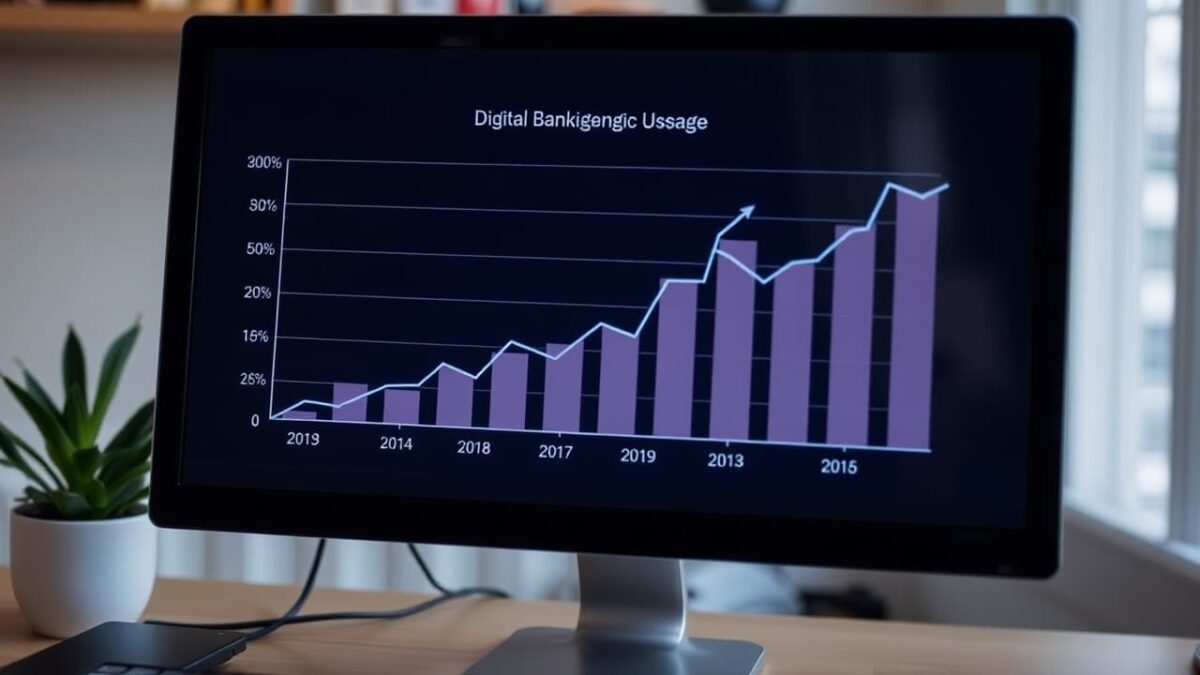Top Banking Trends for 2025: Digital Banking Insights

As we look ahead to 2025, the banking landscape is set to undergo significant changes influenced by technological advancements and shifting customer expectations. This article explores the key banking trends for 2024 that will shape the future of the financial services industry. From the rise of digital banking to the integration of artificial intelligence and blockchain technology, understanding these trends is essential for financial institutions aiming to enhance customer experiences and remain competitive in a digital world.
Overview of Banking Trends for 2024
The banking trends for 2024 indicate a pivotal moment for the financial services industry, particularly as digital transformation accelerates. As we enter 2025, the emergence of digital-only banks, or neobanks, is becoming increasingly prominent. These digital banking services cater to younger demographics who gravitate towards seamless, mobile-first banking experiences. Traditional banking institutions face mounting pressure to enhance their digital offerings or collaborate with fintech companies to retain their market share. Furthermore, the integration of AI and automation will redefine customer service, optimize risk management, and personalize financial advice, ultimately reshaping the banking experience.
Key Developments in Banking Services
Key developments in banking services are rapidly evolving, driven by technological innovations and the increasing demand for enhanced customer experiences. Digital transformation plays a crucial role in this evolution, enabling financial institutions to deliver services more efficiently. The COVID-19 pandemic has acted as a catalyst, propelling digital banks into the spotlight as they expand their customer base and market share. As of 2023, the global number of licensed digital banks had grown to 235, showcasing the robust growth trajectory of online banking and digital finance. Traditional banks must adapt swiftly to these trends or risk becoming obsolete in the face of changing consumer preferences and advancements in technology.
Impact of Digital Transformation on Financial Services
The impact of digital transformation on financial services is profound, reshaping how banking products are accessed and utilized. The rise of digital-only banks highlights a commitment to serving underserved populations and expanding access to financial services, particularly in developing markets. The increasing reliance on technology has led to innovative solutions that improve customer engagement and streamline operations. Financial institutions are leveraging AI and generative AI to enhance customer experiences and improve risk management. The competitive landscape is evolving, and organizations must implement initiatives that harness emerging technology trends to stay relevant in the ever-changing financial sector. As part of this digital evolution, tools like VPN Unlimited are becoming essential for ensuring secure and private online transactions, further enhancing the digital banking experience.
Emerging Fintech Innovations
Emerging fintech innovations are revolutionizing the banking landscape, with trends such as embedded finance and Banking-as-a-Service (BaaS) gaining traction. By integrating financial services into non-financial platforms, digital banks are not only enhancing their customer experiences but also creating new revenue streams. Advancements in AI and machine learning are unlocking new use cases, allowing banks to offer personalized financial products while managing risks more effectively. Additionally, the rise of blockchain technology is opening up possibilities for smart contracts and cross-border payments, promising to reshape the future of banking. These innovations are essential for improving operational efficiencies and transforming the overall banking experience.
The Rise of Digital Banking and AI
Integrating AI into Digital Banking
Artificial intelligence (AI) is becoming an integral component of digital banking, significantly enhancing various aspects of customer interaction and service delivery. By 2025, AI is expected to play a crucial role in automating customer service through chatbots, which will proficiently handle routine inquiries. This automation frees up human agents to focus on more complex issues, thus improving the overall banking experience. Additionally, AI algorithms are pivotal in fraud detection and risk management, allowing financial institutions to identify emerging threats more effectively. As digital banks refine their AI capabilities, they will offer increasingly personalized financial products and services tailored to individual customer needs, shaping the future of banking.
Generative AI: Future Applications in Banking
Generative AI is set to revolutionize the banking sector by enabling the creation of highly personalized financial solutions. This advanced technology analyzes vast amounts of customer data to generate insights and recommendations, which enhances the decision-making process for both banks and their clients. As generative AI becomes more prevalent, it will facilitate the development of customized savings plans and investment strategies. These innovations will align financial products more closely with individual goals and preferences. The potential for generative AI to streamline operations and improve customer engagement is significant, making it a key focus area for financial institutions that wish to innovate and stay competitive within the dynamic financial services industry.
Enhancing Customer Experience with AI
The customer experience in banking is undergoing a significant transformation, driven by AI’s capabilities to deliver personalized interactions. By leveraging advanced data analytics, banks can anticipate customer needs and offer tailored solutions, greatly enhancing satisfaction and loyalty. AI technologies enable banks to provide proactive recommendations, such as suggesting suitable mortgage products based on individual spending behavior. As customer expectations continue to evolve, the ability to deliver a seamless and personalized banking experience will become a critical differentiator for financial institutions. The ongoing integration of AI into digital banking services promises not only to enhance customer experience but also to transform the overall landscape of the financial services industry.
Exploring Digital Currencies and Crypto
Trends in Digital Currencies for 2025
The landscape of digital currencies is rapidly evolving, with a growing focus on the integration of cryptocurrencies into mainstream financial services. By 2025, financial institutions are expected to explore the potential of digital currencies for facilitating transactions and enhancing payment systems. The rise of Central Bank Digital Currencies (CBDCs) is anticipated, as governments look to modernize their monetary systems and streamline banking operations. As banks adapt to these digital banking trends, they will need to address regulatory challenges and ensure they have robust frameworks for managing digital assets, ultimately shaping the future of banking and enhancing customer experiences.
The Role of Crypto in Financial Services
Cryptocurrencies are increasingly becoming part of the financial services ecosystem, with banks beginning to offer crypto-related products and services. This trend is driven by growing consumer interest in digital assets and the potential for cryptocurrencies to facilitate faster and cheaper transactions. As digital banking services evolve, banks are exploring ways to integrate crypto into their existing offerings, including investment products and payment solutions. However, the volatility and regulatory uncertainties surrounding cryptocurrencies pose significant challenges that financial institutions must navigate as they expand their crypto services. This integration represents a pivotal step in the digital transformation of the banking sector.
Risk Management in a Digital Currency Landscape
As the adoption of digital currencies increases, effective risk management will become crucial for financial institutions. Banks will need to develop comprehensive strategies to mitigate risks associated with digital currencies, including market volatility, regulatory compliance, and cybersecurity threats. Implementing robust risk management frameworks will be essential to protect customer assets and maintain trust in the digital finance ecosystem. Additionally, financial institutions must stay abreast of regulatory developments and ensure compliance with evolving standards to safeguard their operations in the digital currency landscape, ultimately enhancing the overall banking experience for their customers.
Trends to Watch in Financial Technology

Cybersecurity Challenges in Digital Banking
With the explosion of digital banking, the importance of cybersecurity has surged dramatically, making it a paramount concern for financial institutions. As cyber threats evolve in complexity and sophistication, banks must invest heavily in advanced cybersecurity measures. This includes implementing AI-driven threat detection systems and multi-factor authentication protocols to safeguard customer data and transactions. Compliance with stringent privacy regulations like GDPR and CCPA is essential, as a significant breach can severely impact a bank’s reputation and erode customer trust. Thus, establishing robust cybersecurity strategies is not just a regulatory obligation, but a critical initiative for sustaining operations in the ever-evolving digital world.
Chatbots and Their Role in Banking Services
Chatbots are increasingly being woven into the fabric of banking services, revolutionizing customer interaction and service efficiency. By 2025, it is anticipated that banks will heavily rely on AI-powered chatbots to manage routine inquiries, freeing human agents to tackle more complex customer needs. This shift not only enhances response times but also significantly improves the overall customer experience, aligning with the trends to watch in digital banking. As chatbot technology continues to mature, banks will be able to offer highly sophisticated and personalized interactions, further solidifying the role of AI in shaping the future of banking services.
Financial Planning in the Age of Digital Finance
In the age of digital finance, financial planning is becoming more accessible and tailored to individual needs. Innovative digital tools and platforms empower consumers to manage their finances effectively, providing insights and recommendations based on unique spending patterns and personal financial goals. As financial institutions leverage advanced data analytics, they can offer bespoke financial planning services that cater specifically to the diverse needs of each customer. This trend is expected to gain momentum, with banks focusing on enhancing the financial literacy of their clients and empowering them to make informed decisions, ultimately reshaping the financial services industry.
Looking Ahead: Banking Trends for 2025
Understanding the Future of Traditional Banking
The future of traditional banking is intricately tied to digital transformation and rapid technological innovation. As digital banks continue to capture market share, traditional banking institutions face mounting pressure to evolve their business models to remain competitive. This may involve enhancing their digital capabilities, forging strategic fintech partnerships, and adopting cutting-edge technologies to enrich customer experiences. The lines between traditional and digital banking are increasingly blurred, and institutions that proactively embrace change will be better positioned to thrive in the dynamic financial landscape of 2025.
Technological Trends Shaping the Future of Finance
Technological trends such as artificial intelligence, blockchain, and open banking are poised to significantly influence the future of finance. By 2025, banks will increasingly incorporate these technologies to boost operational efficiencies, enhance customer engagement, and create innovative new revenue streams. The emergence of open banking is expected to facilitate greater collaboration between banks and fintechs, leading to the development of creative financial products and services. As these technology trends unfold, financial institutions must remain agile and adaptable to exploit their full potential, ensuring they stay at the forefront of the financial services industry.
Preparing for Changes in Customer Expectations
As customer expectations continue to evolve, banks must proactively prepare to meet the demands of a more tech-savvy clientele. By 2025, consumers will anticipate seamless, personalized experiences across all banking channels, necessitating significant investments in data analytics and AI. These advancements will enable banks to anticipate customer needs and deliver tailored solutions effectively. Moreover, as sustainability becomes increasingly important to consumers, banks will need to align their services with Environmental, Social, and Governance (ESG) principles to attract and retain customers. Adapting to these changing expectations will be crucial for banks striving to remain competitive in the digital age.
